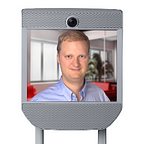Simplicity forces creativity
Or, necessity is the mother of invention. [1]
Sometimes, constraining yourself is the best way to be creative. Medium, to which I’m still new, is a good example. I’m finding that the minimalist UI, presentation, and limited set of editing tools brings focus back to your words. You can’t dazzle people with a slideshow or embedded videos. You must communicate in language that is clean, clear, and descriptive.
We recently had a similar experience with Beam. The remote presence device itself has only one button on it—the power button. Overall, we want to make every personal interaction through Beam as natural as possible. We don’t want people to have to change their behavior. (“If you see a stylus, they blew it.”) People don’t have buttons you can push (I mean physical ones). Talking or working with someone in a Beam should be no different than if they were physically there. They are there.
In many ways, this is why videoconferencing and telepresence have been a disappointment, compared to what people projected a decade ago. The tools create too much friction. I have to call you. You have to answer. We have to book a room. Someone has to move a computer around. And so on. This isn’t being there.
But this simplicity does create challenges. Recently, we were looking for a way for local people to easily see the status of a device. But we have no buttons! After some brainstorming and experimentation, we came up with something we like: Push for status.
With a gentle push, the device turns its screen on and shows you its status. To save power, it turns the screen back off after 30 seconds.
It’s kind of like saying to the device, “Hey, wake up, what are you doing?” But in a friendly way, of course.
[1] Commonly attributed to Plato in The Republic.
